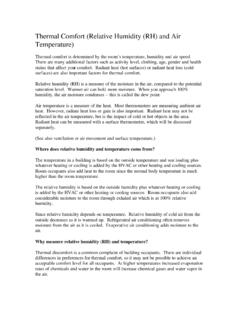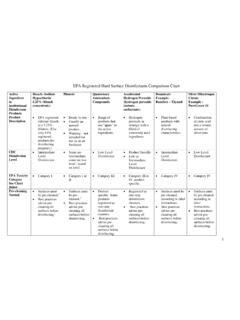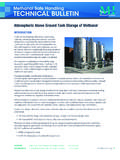Transcription of Aboveground Storage Tank Operator Handbook
1 Aboveground Storage Tank Operator Handbook Second Edition January 2003. Alaska Department of Environmental Conservation AST Operator Handbook , First Edition INTRODUCTION & TABLE OF CONTENTS. Oil spills are ugly, costly and can damage our health and the environment. In Alaska, thousands of gallons of oil and oil products are spilled every year at Aboveground Storage Tank (AST) facilities. Most of these spills are caused by Operator error, poor operation practices and inadequate mainte- nance. In order to reduce the number and size of spills at these facilities, operators should be trained in facility operations and maintenance, safety, spill preparedness, spill response, reporting, clean-up and government re- quirements.
2 This Handbook is designed for AST operators and should be used as a guidebook as well as a reference manual. In this Handbook you will find: INTRODUCTION. Facilities = Tank Farms Step by step procedures for maintaining and inspecting AST facili- ties, preventing oil spills, taking safety precautions, preparing for and responding to oil spills. Checklists for easy reference to inspect AST facilities, transfer fuel, prepare for and respond to spills. An explanation of government requirements relating to AST facili- ties. References and contacts for further information on AST facilities January 2003 Introduction, Page 1.
3 AST Operator Handbook , First Edition INTRODUCTION & TABLE OF CONTENTS. Section One - Facility Opetations & Maintenance Page Aboveground Storage Tank 2. Aboveground Storage 4. Facility 6. Secondary Containment .. 8. TABLE OF CONTENTS. Ancillary Spill 12. Causes of Oil Spills at AST 13. Prevention 15. AST Facility Maintenance ..16. AST Facility 19. Transfer 28. Inventory .. 35. Section Two - Safety Fire and 2. General Facility Safety .. 2. Personal 3. First 4. Introduction, Page 2 January 2003. AST Operator Handbook , First Edition INTRODUCTION & TABLE OF CONTENTS. Section Three - Spill Preparedness Page Facility Analysis and Inspection.
4 2. Spill Response Equipment and Materials .. 4. Spill Response Equipment Checklist .. 5. Spill Response Materials Checklist .. 6. TABLE OF CONTENTS. Operator Preparedness Training .. 7. Spill Response Plans .. 8. Local Response Agreements .. 9. Example Response Container Section Four - Spill Response & Reporting Detecting Oil Spills .. 2. Where Spills are Likely to Happen .. 3. Spill Response .. 4. Spill Reporting .. 10. Spill Response Checklist .. 11. Section Five - Government Requirements State and Federal Regulatory Agency 2. January 2003 Introduction, Page 3. AST Operator Handbook , First Edition INTRODUCTION & TABLE OF CONTENTS.
5 Environmental Protection Agency .. 4. United States Coast Guard .. 9. Alaska Department of Public Safety (Fire Marshall).. 11. Alaska Department of Environmental Conservation .. 12. Appendix A - Industry Standards Industry Standards - General 2. TABLE OF CONTENTS. Addresses for Industry Standards .. 3. Industry Standards for Facility Piping .. 5. Industry Standards for Tank Design & Construction ..6. Industry Standards for Tank Operation .. 9. Industry Standards for AST Maintenance ..11. Fire Protection .. 12. AST Related Industry Standards .. 13. Appendix B - Materials Safety Data Sheet Texaco Diesel # Chevron Unleaded Gas.
6 5. Appendix C - SPCC Plans SPCC Plan Instructions ..2. Introduction, Page 4 January 2003. AST Operator Handbook , First Edition INTRODUCTION & TABLE OF CONTENTS. TABLE OF CONTENTS. Sample SPCC Plan ..17. Appendix D - Operations Manual Operations Manual Completion Coast Guard Response Plan Appendix E - Glossary TABLE OF CONTENTS. January 2003 Introduction, Page 5. SECTION ONE - FACILITY OPERATIONS & MAINTENANCE. MAINTENANCE. SECTION ONE. OPERATIONS. FACILITY. &. AST Operator Handbook , First Edition SECTION 1 - FACILITY OPERATIONS & MAINTENANCE. Section One Table of Contents Page Aboveground Storage Tank 2.
7 Aboveground Storage 4. Facility 6. SECTION ONE - TABLE OF CONTENTS. Secondary Containment .. 8. Ancillary ..10. Spill 12. Causes of Oil Spills at AST 13. Prevention 15. AST Facility Maintenance ..16. AST Facility 19. Transfer 28. Inventory 35. January, 2003 Section 1, Page 1. AST Operator Handbook , First Edition SECTION 1 - FACILITY OPERATIONS & MAINTENANCE. An Aboveground Storage Tank (AST) Facility or tank farm consists of tanks (including day tanks ), piping, secondary containment and ancillary equip- ment. These facilities are used to store fuel that will be dispensed at the site, delivered elsewhere, or transferred to other locations such as day tanks .
8 This manual is directed toward AST facilities that are regulated by the Environ- mental Protection Agency (EPA) but not necessarily by the Alaska Depart- Aboveground Storage TANK FACILITIES. ment of Environmental Conservation (ADEC). EPA regulates facilities that have a Storage capacity of 1,320 gallons or more and ADEC regulates facilities with a Storage capacity of 420,000 gallons or more. Section 1, Page 2 January, 2003. AST Operator Handbook , First Edition SECTION 1 - FACILITY OPERATIONS & MAINTENANCE. Aboveground Storage TANK FACILITIES. January, 2003 Section 1, Page 3. AST Operator Handbook , First Edition SECTION 1 - FACILITY OPERATIONS & MAINTENANCE.
9 Aboveground Storage tanks Aboveground Storage tanks (ASTs) come in many different sizes. Most ASTs have cylindrical sides or shells and flat tops and bottoms. They are set vertically (on end) or horizontally (on sides). Most ASTs are constructed out of steel. Older tanks have riveted or bolted seams and newer tanks are welded. Aboveground Storage tanks . Fuel Storage tanks must be vented so fumes can escape, reducing the potential for ruptures and collapses. ASTs should have cathodic protection, such as sacrificial anodes, to reduce corrosion. To reduce the chances for corrosion, tanks should be placed on a pad, foundation or supports rather than directly on the ground.
10 tanks should be painted with a light color and rust free. tanks should be labeled as to contents, size, last internal inspection, safe gauge height and year built. tanks must be have overfill protection, this would be direct vision gauges, high liquid level alarms , flow restrictions or high liquid level shut-off devices. See Appendix A for additional technical information. Horizontal AST. Vertical AST. Double-walled AST. Section 1, Page 4 January, 2003. AST Operator Handbook , First Edition SECTION 1 - FACILITY OPERATIONS & MAINTENANCE. Aboveground Storage tanks - common features Aboveground Storage tanks .









